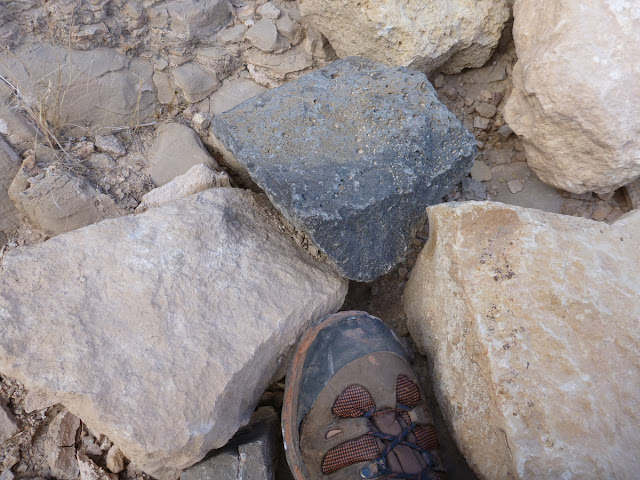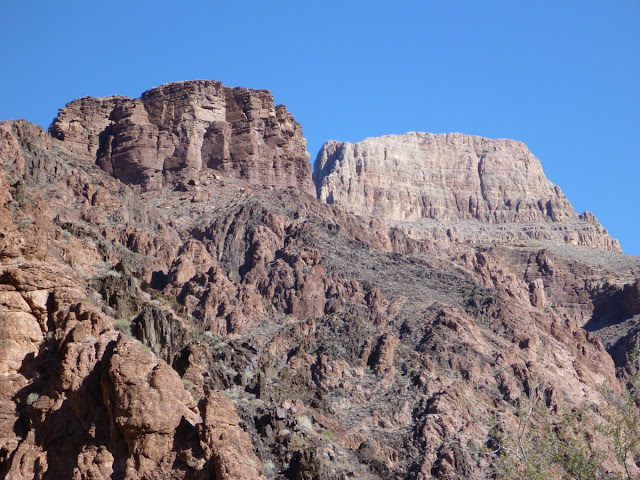Helen and I spent 6 days inside the Grand Canyon between December 27 and January 1. It was downright cold at the bottom but still 20 degrees warmer than out on top. Lots of fun - lots of great winter light for photos. I never tire of looking at these rocks. Have a look.
The canyon danced with winter clouds filled with snowflakes as we began the hike down about 1 PM
It was all magical - the light, the clouds, the tilted Supergroup poking up through Tapeats Sandstone
Snow always brings out the regularity of the layering of strata in the Southwest
And then, just as fast, it all hides momentarily in a veil of cloud
Subdued colors on O'Neill Butte (Supai Group) and the Red and White switchbacks in the Redwall (lower right)
The lights come back on a little farther down the trail
At the top of the Redwall, the trail swings to the west and displays another glorious sight
Zoomed in, we see the Cambrian Tapeats Sandstone (left) capping the Precambrian schist. Note how the Tapeats pinches out to the right with orange Hakatai Shale creating a paleo-high that precluded deposition of the Tapeats in the upper center of the photgraph. I just love paleo-highs! Pre-existing topography makes me happy!
That's my campground down there behind the rainbow
Hey? What is this piece of vesicular basalt doing along the trail in the Redwall Limestone? Is the treail crew bringing exotic rocks into the canyon? I saw three of these!
Eye-level view of the Grand Canyon Supergroup rocks across the gorge of the Colorado River
Self-portrait taken about 3:30 Pm on the Tonto Plateform at the Tip-Off
Finally, Bright Angel Creek delta poking out into the channel of the Colorado River! Look at how all of that debris came pouring out of the canyon to constrict the larger channel of the river. Awesome!
While staying at the bottom, there is ample time to explore the local environs. From the delta near the river, this is a view up to Sumner Butte (Redwall mass on the right) and a lower unnamed promontory of the Tapeats Sandstone. I've always wanted to go out onto that promontory that looms over the delta area and today was the day.
We took the Clear Creek Trail up and got a good view of Phantom Ranch below. Here it was the 4th to last day in December and the cottonwood trees looked like the hight of autumn anywhere else.
Farther on the trail, the Kaibab Bridge was visible across the river
And looking to the east, we saw the deep defile of the Inner Gorge upstream on the river above Phantom Ranch
A downstream view. Everywhere we looked the light, color, and textures were brilliant
Finally, we left the trail and headed west across unbroken terrain. This is the top of the Tapeats Promontory (a new name!). Across Bright Angel Creek see some more grand paleo-topography. At eye-level on the far left and far right are blocks of Grand Canyon Supergroup, the upturned edges of this imaginary saucer. In the middle, is the Tapeats Sandstone, filling in the space between these two paleo-highs. See the training graph below.
Here is the same photo with all pertinent features labeled. Compare with the photo above to experience how a geologists mind works when they look out on the landscape of the Grand Canyon. Also, see Dr. Jack Share's excellent explanation of the faults in this area
at this link.
Wayne, Helen, and Amanda in the back of the house at Phantom Ranch on a celebratory night. Photo courtesy of Sueanne Kubicek.
Partaking of the smoked trout at the Ranch. Photo courtesy of Sueanne Kubicek.
A New Day. A New Year. 2013 arrives but these ripples in the Hakatai Shale record one New Year's Day some 1,250 million years ago. Well, why not New Year's Day. Aren't they beautiful!
Up the Kaibab, a last look at Sumner Butte and its older brother, Zoroaster Temple, capped with a thin remnant of the
Seligman Member of the Toroweap Formation
It was a cold and beautiful start to the New Year. Here, a Phantom packer and mules bring more beer to Phantom Ranch!
Stromatalites present in the Hakatai Shale along the Kaibab Trail
The Grand Canyon - natures masterpiece. Happy New Year everyone!
















































